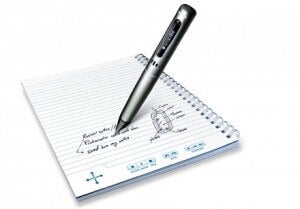
I take a lot of notes. Right now next to me is a thick stack of loose leaf paper full of my thoughts on strange gadgets, nanotechnology, and obscure science fiction references I plan to use. Like most madmen I mutter out loud while scribbling my ideas, which is why I’m excited about the Pulse Smartpen from Livescribe. It records audio and synchronizes it with what you write. You can play playback the linked audio just by tapping on the appropriate area of your notes, which turns everything you write into a visual cue card for the audio recording. Your notes and audio can be exported as a “pen cast” for friends. There are even downloadable third party applications for things like dictionaries, language translations, homework help, games, etc. What is this thing, an iPhone? The Pulse looks like the ideal tool for students, journalists, and doctors. Check out the demo videos from Livescribe after the break.
There are many, many, many digital pens on the market. Most are sold as homework assistants, many transcribe writing, and some even have voice recorders for notes. Yet the Pulse Smartpen is the first I’ve seen that synchronizes all the media together and provides the means to broadcast your notes to friends. The inclusion of an Apps Shop really makes me think that Livescribe is going to push this smartpen as a viable development platform. The combination of all-inclusive design and software add-ons could give the Pulse the means to become a very popular tool for its selected demographic (students, executive assistants, journalists, etc). Outside of that market, the pen is unlikely to make waves although it does give credence to one of Ray Kurzweil‘s predictions about technology: everything will become a computer. Phones, pens, bathroom scales, watches, and cars are already on the list of ‘smart’ objects. Almost anything could be next.
I feel like Livescribe hired a marketing firm from the 90s to make these commercials. Still, they tell you what you need to know. Enjoy.
The Pulse works by using an IR camera embedded in the front of the device to read the position of your pen on a piece of paper that has been specially dotted. When you playback your notes, the smartpen isn’t reading what you’ve written as much as it is synchronizing the audio to a physical location on the page. This could lead to trouble if you tend to write over the same space often, but a small change in note habits should provide the means to keep things organized. Tapping on special keyed-in sections on the paper can control recording and playback. There are even pianos, calculators, and other paper-based programs you can access if that’s something you need in a pen.
Currently, the Pulse comes in three levels: 2 GB ($170), 4GB ($200), and 4 GB with transcription software and black leather accessories ($230). Now, 4 GB is enough for 400 hours of audio recording (less depending on quality) so I can’t imagine why you wouldn’t just settle for the 2 GB. Do you really need more than 200 hours? The transcription software, which changes your handwriting into digital text, sells separately for $30. All three versions of the Pulse can charge, download content, and upload recordings via a USB connection for your computer. And all three have the same ~18 x 90 pixel OLED output screen capable of displaying complex characters (like Japanese Kanji).
The add-ons will keep you paying small amounts for a long time, unfortunately. That specially dotted paper can be made with a regular printer (600 dpi or better required), but the Livescribe store sells an 80 page journal for around $5. Ink is going to cost you $6 for a pack of five cartridges. You’re likely to use a cartridge or two per 80 page journal (depending on how much you write). Most applications at the Apps Store cost between $0-$3, though if you want a Spanish dictionary ($15) or a guide to Hebrew chanting ($100) you’ll pay a little extra.
Actually, it’s the physical necessity of paper and ink that disappoints me. While the synchronization of ink and audio is what makes Pulse so innovative in the first place, half of that equation is a dying medium. We don’t need ink and paper anymore. Ideally, smartpens should work by turning any surface into a tablet PC and recording your audio while doing so. There’s got to be some combination of Kindle and smartpen, or smartphone and IR-enabled stylus that could take us to the next level.
As is, the Pulse is still a pretty cool piece of technology. I’m interested to see how “pen casts” will affect colleges that are already moving an increasing amount of their classwork online. Could the test of the future require you to record yourself as you took it? The phrase “show your work” will have a whole new meaning for science and math majors everywhere. Doctors and engineers may find that sort of sharing very beneficial as well. Google is already experimenting in this field with programs like Google Docs and Google Wave. If the concept of the smartpen takes off, it will be a way for us to share ideas more efficiently. We don’t have SimStim yet, but we’re getting there.
Obscure scifi reference was a success – thanks, notes!
[photo and video credits: Livescribe]


